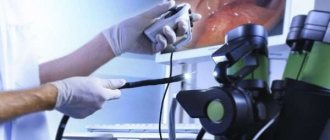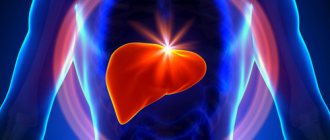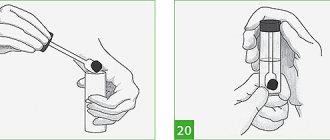Have you been struggling with GASTRITIS and ULCERS for many years without success?
“You will be amazed at how easy it is to cure gastritis and ulcers just by taking it every day...
Read more "
People who come to hospitals with complaints of pain in the intestines, disruption of bowel movements, nausea and vomiting are required to undergo basic tests, which include stool culture. It is a fairly popular method of laboratory examination of feces, thanks to which specialists are able to diagnose acute intestinal pathologies, as well as identify the causative agents of illnesses.
When should you donate stool to a culture tank?
A stool test is prescribed to patients who exhibit symptoms characteristic of intestinal pathologies:
- the temperature has risen;
- vomiting occurs;
- nausea appears;
- painful sensations occur in the peritoneal area;
- diarrhea began, etc.
Based on one clinical picture, specialists will not be able to make an accurate diagnosis; they can only assume the development of a particular disease. To confirm their assumptions, they must conduct a comprehensive examination of patients, based on the results of which they will be able to diagnose the disease and identify its causative agent.
It is worth noting that sanitary and epidemiological standards approved at the legislative level oblige people with certain professions to regularly submit feces for bacterial culture.
This list includes professions related to:
- with transportation, packaging, sale, production of food products;
- with cleaning of premises located in public catering establishments;
- with cutting meat, poultry, fish, etc.
Also, people working in kindergartens, schools, medical institutions and other places where they constantly have to come into contact with food should undergo regular examination. All laboratory test results for workers are recorded in health records.
How further processing of feces occurs
After the material for analysis is received, it is sent to the laboratory in a sterile container.
As soon as possible from the moment of collecting stool, it is inoculated on a solid colored medium - Levin's medium or Bacto-agar F, as well as on accumulation medium (Kaufman, Muller). The crops made are sent to a thermostat for a day, where they are kept at a temperature of 37 degrees Celsius. If the feces were collected on a swab, it is applied to a cup with a solid colored medium and dispersed with a spatula. Within a day, the material is ready for examination.
Tank culture of stool for intestinal group
The human intestine, which does not have any pathologies, contains approximately five hundred varieties of microorganisms that are very actively involved in the process of food processing.
Modern medicine classifies them as follows:
| Types of microorganisms | What bacteria are replenished by the group? |
| Useful | They take part in digestive processes, help strengthen local immunity, and generate vitamins. The group of beneficial microorganisms should be replenished with mushrooms, Escherichia, lactobacilli, bacteroides, and bifidobacteria. |
| Conditionally pathogenic | There are fifteen species of opportunistic microorganisms in the human intestine. They do not cause any harm as long as no pathological processes occur in the body. Once the immune system is weakened, such bacteria can cause serious problems. This group should be replenished with: candida fungi, clostridia, Escherichia coli, enterococci, staphylococci. |
| Pathogenic | A healthy person should not have pathogenic microflora in the intestines. But, some bacteria are able to very successfully camouflage themselves and maintain vital activity in the organ while in the form of cysts. At the same time, people will not even suspect that they are carriers of infections. This group should be replenished with: Vibrio cholerae, balantidia; trichomonas intestinalis, dysenteric amoeba, shigella, salmonella. |
When prescribing a stool test for the intestinal group to a patient, the specialist is guided by the following motives:
- It will be possible to identify the source of infection.
- It will be possible to establish a circle of contact persons and conduct a survey of them.
- It will be possible to limit the source of the spread of the disease.
- It will be possible to cure the disease by prescribing the patient an effective course of drug therapy.
When conducting a laboratory examination of stool, specialists are able to identify intestinal groups that provoke such ailments:
| Salmonellosis | Pathogenic microflora affects the small intestine. As the disease progresses, patients develop symptoms characteristic of severe intoxication. The disease is extremely dangerous for children, as complications can cause the development of sepsis, meningoencephalitis, and pneumonia. Infection with salmonella occurs when personal hygiene standards are not observed, when food is poorly washed or not washed at all, or unboiled water. |
| Dysentery | The development of the disease is caused by a pathogenic microorganism called Shigella. As the disease progresses, the large intestine and stomach are seriously affected. The infectious agent enters the body through dirty foods and unwashed hands. |
| Coli infections | In this case, the group includes ailments whose development is provoked by Escherichia coli. Most often, such problems are encountered by infants, in whom the large intestine becomes the affected area. Infection occurs during contact of a healthy person with a carrier. Children become infected when adults do not comply with banal sanitary and hygienic standards |
What is dysbiosis
Dysbiosis is an imbalance of bacteria living in the intestines
under the influence of various factors (taking antibiotics, poor diet).
Recently, pathology is often observed in very young children.
Features of the disease in newborns and infants
The risk group includes the following categories of children:
In babies who receive breast milk, dysbiosis develops much less frequently. Their intestinal microflora consists of 90% lactobacilli and bifidobacteria.
Signs of impaired intestinal microflora in newborns and infants are as follows:
- bloated stomach;
- bad breath;
- stomach ache;
- formation of gases in the intestines;
- secretion of a large amount of saliva;
- dry and tight skin;
- the appearance of allergic rashes on the skin;
- inflammation of the oral mucosa;
- signs in the mouth;
- difficult stool;
- diarrhea for three or more days;
- vomiting after eating;
- problems gaining weight;
- greenish foamy stool, possibly blood.
According to the World Health Organization, imbalance of intestinal microflora is not a disease. Some foreign experts suggest not interfering with this condition and allowing the body to independently regulate this process. However, most doctors are of the opinion that therapy is still necessary.
To fully evaluate bowel function in a newborn or breastfed infant, the following tests must be performed:
- coprogram (reveals the digestive activity of the intestine, inflammatory processes);
- sowing stool for opportunistic flora (shows how many neutral bacteria are in the intestines);
- tank. stool culture for dysbacteriosis (reveals the percentage of normal and opportunistic intestinal microflora).
According to some experts, it is incorrect to talk about dysbiosis in newborn babies. Children are born with a sterile intestine, which is gradually colonized by bacteria, so it is difficult to judge their normal ratio and quantity.
Causes of imbalance of intestinal microflora in adults and children
Dysbacteriosis can develop in children of preschool and school age, as well as in adults. Most often, the following reasons lead to this condition:
- taking antibiotics;
- eating disorder;
- the presence of a large amount of sweets in food, lack of coarse plant fiber;
- changing your usual food and water when moving to another area;
- infectious intestinal diseases (shigellosis, salmonellosis);
- general decrease in immune system activity;
- operations on the stomach and intestines;
- inflammatory diseases of the stomach and intestines (gastroenterocolitis).
Dysbacteriosis in men and women usually has the same causes. However, the following factors can also contribute to the development of pathology in the fairer sex:
- women's passion for strict diets;
- frequent bowel cleansing using enemas;
- addiction to laxatives for the purpose of losing weight;
- more active treatment with antibiotics.
What signs may indicate the presence of pathology?
Symptoms of dysbiosis in adults and children of preschool and school age:
- bloating and abdominal pain;
- decreased appetite;
- nausea and vomiting;
- undigested pieces of food in stool;
- the appearance of a white coating on the tongue;
- bad breath;
- decreased vitality, fatigue;
- periodic acute abdominal pain;
- dry and brittle hair;
- the appearance of bleeding gums and dark plaque on the teeth.
To confirm objective signs of dysbiosis, it is necessary to do a microbiological examination of stool. This analysis will show the concentration and ratio of beneficial microorganisms (bifidobacteria, lactobacilli, bacteroides) and opportunistic ones, as well as the presence of pathogenic bacteria (shigella, salmonella).
Doctor Komarovsky about dysbiosis - video
Preparation for analysis, laboratory research
In order for the result of a laboratory examination of stool to be as accurate and informative as possible, patients must properly prepare for it:
- Five days before collecting biological material, a person must exclude meat and fish dishes from his menu. The diet should include white varieties of baked goods, potato dishes, cereals and dairy products. It is strictly forbidden to drink alcohol-containing drinks during these days.
- Three days before the collection of biological material, the patient must stop taking medications. You should also avoid using rectal suppositories.
The collection of biological material can be carried out personally by the patient at home. To do this, he needs to purchase a sterile container with a hermetically sealed lid from the pharmacy chain. If it is not possible to buy a disposable container, the patient can use a glass jar, which has been thoroughly washed and sterilized, as a container. If the baby needs to be tested, then the mother can take the required amount of feces directly from his diaper.
Stool collection can be done in a hospital setting. To do this, the patient will be asked to lie down on the couch and turn on his side. At this time, the laboratory assistant makes a smear, for which he uses a sterile swab, which is inserted to a shallow depth into the rectum, and then scrolled. The removed swab with biological material is placed in a test tube, which already contains a special medium.
Rules for collecting feces
If a person plans to independently collect feces and transfer them to a laboratory for research, he must adhere to the following rules:
- Foreign matter, such as blood, urine, mucus, should not enter the feces.
- If the patient uses a glass jar as a container, then no disinfectants should be used during its sterilization. You can destroy all bacteria in the following way: wash the jar thoroughly and then douse it with boiling water several times.
- If you plan to collect feces from your baby, then before putting him on the potty, the mother should carry out the same manipulations as with a glass jar.
- The collected biological material must be immediately delivered to the laboratory; the patient is allocated no more than two hours for this. If the analysis is temporarily placed in the refrigerator, the delivery time increases to four hours. Patients should understand that the later they deliver feces to a hospital facility, the less accurate and informative the bacterial culture result will be.
Features of laboratory research
Laboratory assistants place the collected feces in a small amount on a nutrient medium. Within 4-5 days, colonies of microorganisms should grow in them, from which specialists will be able to prepare a smear for the intestinal group. Even if a small amount of bacteria grows during this time, laboratory technicians will still be able to do the analysis.
Further work with biological material is carried out under a microscope. Thanks to the equipment’s ability to magnify even microscopic elements, specialists will be able to determine the type of microorganisms present in feces by appearance and mobility. Experienced laboratory technicians will be able to give preliminary results of bacterial culture on the first day.
But, for greater confidence, they should carefully examine the causative agent of an intestinal infection, which actively grows in a nutrient medium within five days, for example:
- Salmonella - bile broth.
- Shigella - all environments.
Culture of stool allows one to identify not only the pathogen present in the human intestine, but also to determine the level of its sensitivity to a particular antibiotic. When working with biological material from a patient, laboratory assistants conduct biochemical testing. The results obtained allow us to draw conclusions on the qualitative and quantitative composition of its intestinal group.
It will take laboratory technicians approximately a week to conduct a complete examination of a patient's feces. To speed up this process, some hospitals use express methods. But the results of such studies will not be as reliable as possible.
The result of bacterial culture for the intestinal group will take into account the presence of the entire spectrum of microorganisms in the feces. Their number per gram of feces is counted in CFU. If the patient underwent an extensive analysis, then its result may indicate the presence of dysbacteriosis. The patient must pass the result obtained to the attending physician, who will decipher it and, if a pathogenic microflora is identified, prescribe an effective course of drug therapy.
Classification
Tank tests can help a doctor diagnose not only gastrointestinal infections, but also other diseases. For example, tank tests from gyno () can be diagnosed in women. As mentioned earlier, lactobacilli live not only in the intestines, but also in the vagina of women in a certain amount. A violation of the ratio of opportunistic, pathogenic and “beneficial” bacteria can provoke a disease such as bacterial vaginosis.
The doctor may prescribe a disgroup if the patient's symptoms indicate blood poisoning. Indications for tank blood test:
- elevated temperature (for a long time);
- suspected infectious diseases.
Usually, a blood culture test is taken before starting a course of antibiotic therapy, since after using antibiotics one cannot hope for a reliable test result.
One of the methods for studying the state of human health is bacteriological studies of human waste products, including feces. This type of analysis is usually included in both general preventive examinations and complex, highly specialized diagnostic measures. The collected material, processed in a special way, makes it possible to determine some important indicators of human health, for example, the presence of intestinal dysbiosis or intestinal infections, as well as to monitor the quality of the treatment provided. This analysis can be prescribed to patients of any age.










